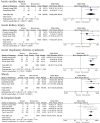Clinical features of severe patients infected with 2019 novel coronavirus: a systematic review and meta-analysis
- PMID: 32566603
- PMCID: PMC7290556
- DOI: 10.21037/atm-20-2124
Clinical features of severe patients infected with 2019 novel coronavirus: a systematic review and meta-analysis
Abstract
Background: 2019 novel coronavirus disease (COVID-19) has posed significant threats to public health. To identify and treat the severe and critical patients with COVID-19 is the key clinical problem to be solved. The present study aimed to evaluate the clinical characteristics of severe and non-severe patients with COVID-19.
Methods: We searched independently studies and retrieved the data that involved the clinical characteristics of severe and non-severe patients with COVID-19 through database searching. Two authors independently retrieved the data from the individual studies, assessed the study quality with Newcastle-Ottawa Scale and analyzed publication bias by Begg's test. We calculated the odds ratio (OR) of groups using fixed or random-effect models.
Results: Five studies with 5,328 patients confirmed with COVID-19 met the inclusion criteria. Severe patents were older and more common in dyspnea, vomiting or diarrhea, creatinine >104 µmol/L, procalcitonin ≥0.05 ng/mL, lymphocyte count <1.5×109/L and bilateral involvement of chest CT. Severe patents had higher risk on complications including acute cardiac injury (OR 13.48; 95% CI, 3.60 to 50.47, P<0.001) or acute kidney injury (AKI) (OR 11.55; 95% CI, 3.44 to 38.77, P<0.001), acute respiratory distress syndrome (ARDS) (OR 26.12; 95% CI, 11.14 to 61.25, P<0.001), shock (OR 53.17; 95% CI, 12.54 to 225.4, P<0.001) and in-hospital death (OR 45.24; 95% CI, 19.43 to 105.35, P<0.001). Severe group required more main interventions such as received antiviral therapy (OR 1.69; 95% CI, 1.23 to 2.32, P=0.001), corticosteroids (OR 5.07; 95% CI, 3.69 to 6.98, P<0.001), CRRT (OR 37.95; 95% CI, 7.26 to 198.41, P<0.001) and invasive mechanical ventilation (OR 129.35; 95% CI, 25.83 to 647.68, P<0.001).
Conclusions: Severe patients with COVID-19 had more risk of clinical characteristics and multiple system organ complications. Even received more main interventions, severe patients had higher risk of mortality.
Keywords: 2019 novel coronavirus; acute respiratory disease; clinical features; disease severity; meta-analysis.
2020 Annals of Translational Medicine. All rights reserved.
Conflict of interest statement
Conflicts of Interest: All authors have completed the ICMJE uniform disclosure form (available at http://dx.doi.org/10.21037/atm-20-2124). The authors have no conflicts of interest to declare.
Figures
















References
-
- WHO. WHO convenes meeting of top scientists to slow coronavirus spread. Disease outbreak news. (Feb 11, 2020, Accessed Feb 17, 2020). Available online: https://www.who.int/emergencies/diseases/novel coronavirus-2019
-
- National Health Commission of the People’s Republic of China. Available online: http://www.nhc.gov.cn (Assessed on February 6 th, 2020).
LinkOut - more resources
Full Text Sources
Miscellaneous
